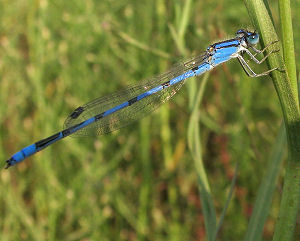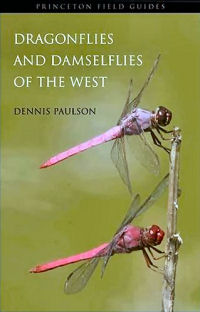
HOME
INTRO
SYMBOLS
ALMANAC
ECONOMY
GEOGRAPHY
STATE MAPS
PEOPLE
FORUM
NEWS
COOL SCHOOLS
STATE QUIZ
STATE LINKS
BOOK STORE
MARKETPLACE
NETSTATE.STORE
NETSTATE.MALL
GUESTBOOK
CONTACT US


Nevada State Insect

Vivid Dancer Damselfly (Male)
Photograph: Jack Wolf
(Creative Commons license)
Adoption of the Nevada State Insect
At the end of a December, 2008 meeting of the Board of Directors of the Greater Las Vegas affiliate of "Kids Voting USA," someone asked,
"Did you know that Nevada does not have a state insect designated, and we have a state flower, a state bird, a state rock and others? How would one go about naming a state insect?"
And so it began.
A contest was initiated; open to all fourth grade students in public, private, parochial, and homeschool environments.
"To participate in the contest, the classes were required to submit a one-page, research-based essay supporting the nomination of an insect found in Nevada, including the pupils' rationale for why that insect would be a good symbol for the State of Nevada."
The contest ended on February 20, 2009 and judging took place on February 27.
Seven judges from communities throughout the state read through reports from 74 classrooms. The judges represented the fields of entomology (study of insects) and education.
The winning entry, proposing the vivid dancer damselfly as the state insect, came from Mr. Slater's fourth grade class at John R. Beatty Elementary School in Las Vegas.
On March 4, 2009, Senate Bill No. 166 (SB166) was introduced in the Nevada State Senate by Senator Joyce Woodhouse (Treasurer: Greater Las Vegas affiliate, Kids Voting USA).
S.B. 166
SENATE BILL NO. 166-SENATOR WOODHOUSE
MARCH 4, 2009JOINT SPONSOR: ASSEMBLYMAN STEWART
Referred to Committee on Government Affairs
SUMMARY-Designates the official state insect of Nevada.
(BDR 19-914)FISCAL NOTE: Effect on Local Government: No.
Effect on the State: No.EXPLANATION - Matter in bolded italics is new; matter between brackets [omitted material] is material to be omitted
AN ACT relating to state emblems; designates the Vivid Dancer
Damselfly (Argia vivida) as the official state insect of the
State of Nevada; and providing other matters properly
relating thereto.Legislative Counsel's Digest:
Existing law establishes various official state emblems, including a state bird, state reptile, state animal, state fish and others. (NRS 235.020-235.130) This bill establishes the Vivid Dancer Damselfly (Argia vivida) as the official state insect.
This insect was selected through a contest that was open to all fourth grade and Gifted and Talented Education (GATE) classrooms in Nevada to select a state insect because Nevada is one of only eight states in the country that does not have a state insect. The contest was open to public, private, parochial and homeschooled pupils. To participate in the contest, the classes were required to submit a one-page, research-based essay supporting the nomination of an insect found in Nevada, including the pupils' rationale for why that insect would be a good symbol for the State of Nevada. The 74 classrooms that participated in the contest represented 57 schools in seven counties.
The winners are the fourth grade class taught by Mr. David R. Slater at John R. Beatty Elementary School, which is located on Hidden Palms Parkway in Las Vegas.
On March 18, 2009, three students from John R. Beatty Elementary School offered their essay in testimony before the Senate Committee on Government Affairs in Carson City.
Our class has selected Argia vivida, the Vivid Dancer Damselfly as our submission to the Nevada State Insect Contest. It is a small (about 1.5 inches in length) flying insect and belongs to the family Coenagrionidae of the order Odonata. It was first classified by Hermann August Hagen in 1865, the year after Nevada statehood. Hagen later became the first professor of entomology at the American University, Harvard.
We first voted for Argia vivida because of its colors. The adult male is a rich blue with clear wings that appear silver when rapidly beating in sunlight. Silver and blue are Nevada's state colors. This color scheme is sometimes repeated during mating. While most females are tan or tan ant grey, some are colored a silver grey. After mating, the mail and female fly in tandem (he protecting her from other males) to a spot where she can deposit her eggs on vegetation just below the waterline.
Next we learned the Vivid Dancer Damselfly is abundant in all four regions of our state. Its habitat is the springs and ponds of Nevada. We thought it was important that the state insect not have a limited range or be endangered. It should represent and prosper throughout the entire state.
It was when we discovered Argia vivida is helpful to humans that we believed we had made a great choice. The Vivid Dancer Damselfly preys upon mosquitoes, flies, aphids and other pests. It isn't just pretty. It serves Nevadans by contributing to our economy and quality of life.
There are fifty-five state insects. There are twenty-four butterflies, seventeen bees, seven lady bugs and two dragonflies on that list, but not one damselfly. The selection of the Vivid Dancer would reinforce Nevada's status as unique among the states.
It is for these reasons that we nominate Argia vivida, the Vivid Dancer Damselfly, as Nevada's state insect.
Six days later, on March 24, the Nevada Senate votes there approval unanimously and passed SB166 on to the Assembly for their consideration.
Received in the Assembly on March 27, Assemblyman Lynn Stewart (Community Volunteer, Greater Las Vegas affiliate, Kids Voting USA), took over for Senator Joyce Woodhouse.
Though the legislation languished for a month, most of the time in the Assembly Committee on Government Affairs, the Nevada Assembly also honored the bill with unanimous approval. Voting 42-0, the only remaining obstacle to the legislation becoming law was the Governor of Nevada.
On May 4, 2009, Governor Jim Gibbons signed the legislation naming the vivid dancer damselfly the official state insect of the State of Nevada, effective October 1, 2009.
Nevada Law
The following information was excerpted from the Nevada Revised Statutes, Title 19, Chapter 235, Section 235.062.
TITLE 19—MISCELLANEOUS MATTERS RELATED TO GOVERNMENT AND PUBLIC AFFAIRS
CHAPTER 235 - STATE EMBLEMS; GIFTS AND ENDOWMENTS
MISCELLANEOUS STATE EMBLEMS
NRS 235.062 State insect. The insect known as the Vivid Dancer Damselfly (Argia vivida) is hereby designated as the official state insect of the State of Nevada.
(Added to NRS by 2009, 48)
Sources...
"4th-graders to choose Nevada state insect." RJI.com. Reno Gazette-Journal, 28 Jan 2009. Web. 6 Nov 2013.
75th (2009) Session Bill Information. Nevada Legislature. 2009. 4 May 2009
Additional Information
Vivid Dancer: Photographs and descriptions illustrating life history of damselflies.
Vivid Dancer (Argia vivida): Photographs from Jeff Pippen at Duke University.
Argia vivida Hagen in Selys, 1865: Integrated Taxonomic Information System (ITIS) Here you will find authoritative taxonomic information on plants, animals, fungi, and microbes of North America and the world.
Argia vivida (Vivid Dancer Damselfly): Photos from BugGuide.Net
State Insects: Complete list of official state insects.
More symbols & emblems: Complete list of official Nevada state symbols.

Dragonflies and Damselflies of the West
by Dennis Paulson
Dragonflies and Damselflies of the West, by Dennis Paulson. 536 pages. Princeton University Press (May 3, 2009) Dragonflies and Damselflies of the West is the first fully illustrated field guide to all 348 species of dragonflies and damselflies in western North America. Dragonflies and damselflies are large, stunningly beautiful insects, as readily observable as birds and butterflies. This unique guide makes identifying them easy--its compact size and user-friendly design make it the only guide you need in the field. Every species is generously illustrated with full-color photographs and a distribution map, and structural features are illustrated where they aid in-hand identification. Detailed species accounts include information on size, distribution, flight season, similar species, habitat, and natural history. Dennis Paulson's introduction provides an essential primer on the biology, natural history, and conservation of these important and fascinating insects, along with helpful tips on how to observe and photograph them.
Dragonflies and Damselflies of California, by Timothy D. Manolis. 295 pages. University of California Press; 1 edition (May 8, 2003) "A book that will both educate and delight anyone who wants to know more about these fascinating insects. Packed with facts but written in a straightforward style, the book makes California's 108 dragonfly and damselfly species easily accessible. . . . It will engender a renewed appreciation of the value of our wetlands."--Dennis Paulson, author of Dragonflies of Washington.
 Custom Search
Custom Search

